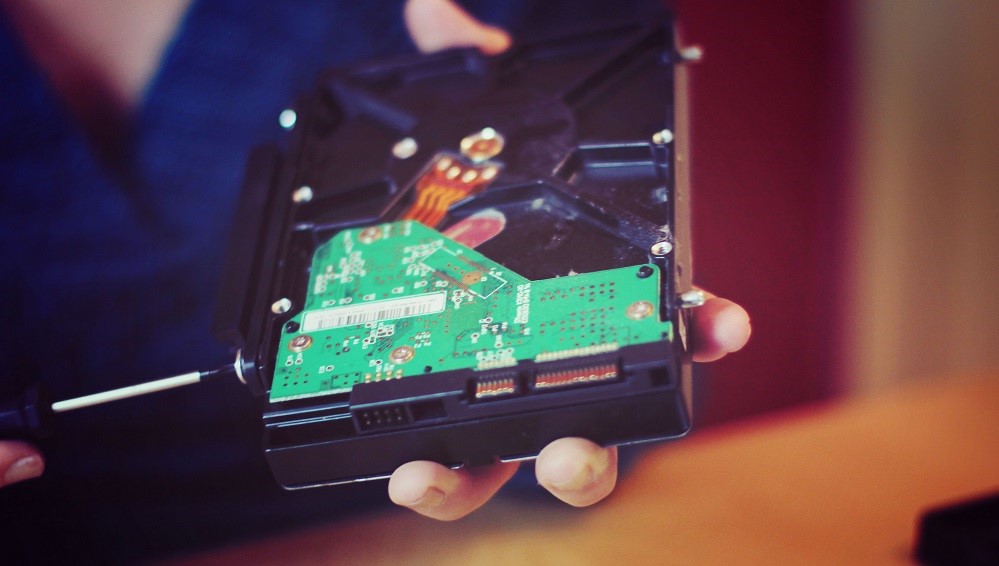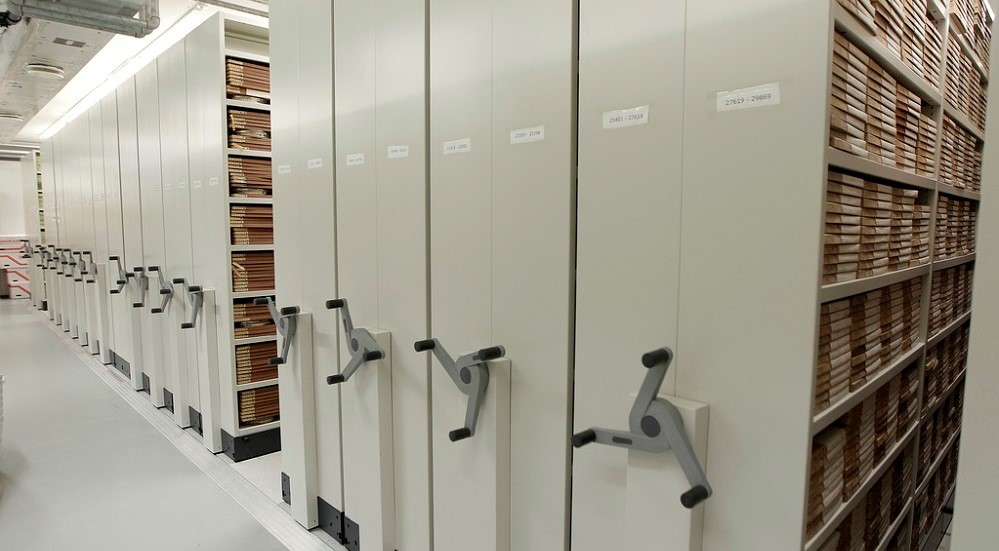Data storage: a brief overview of this year’s trends
This week we told why not all of the implemented “green” technologies in the data center are effective. Today we offer to talk about what is happening in the field of data storage. According to Statista, in 2018, the total amount of data that is “contained” in data centers will reach 1,450 Ebytes, and in this area your own trends are formed, which you need to know.

/ photo by Aaron und Ruth Meder CC
According to IDC, in 2017, the all-flash market value in the corporate sector increased by 76%. Income of companies operating in this area amounted to $ 1.4 billion. At the same time, sales of hybrid flash arrays reached $ 2 billion.
')
In The Register noted that the total supply of SSDs will increase to 313 million in 2021 (with 157 million units in 2016). Research company Technavio connects the growth of popularity and sales of SSD with a decrease in prices for devices. And it is expected that in 2018, manufacturers will continue to reduce prices for drives. Reduction will be from 3 to 6 percent.
The growing popularity of SSD also contributes to a number of technologies and products. We recently talked about one of these solutions - the Optane drive series from Intel. In May 2018, the company introduced a new model - Optane 905P, which is based on the 3D X Point platform. The solution will be available in two form factors: HHHL and a 2.5-inch case. The capacity of the device will be 960 GB, the sequential read speed is 2500 MB / s, and the sequential write speed is 2000 MB / s.
Among the companies that prefer to use solid-state drives instead of hard drives in their data center are Calligo, Facebook and Dropbox. Facebook, for example, uses PCI-E SSDs. Representatives of the organization say that flash memory shows itself well when processing requests. Calligo CEO Julian Box (Julian Box) claims that SSD can improve the performance of virtual machines and not worry about the physical limitations of storage.
Despite the popularity of SSD, hard drives are not going to leave the market. HDD manufacturers are also trying to increase performance by increasing disk capacity.
Although the price of SSDs is gradually decreasing, SSDs are, on average, 6.6 times more expensive than HDDs. IDC predicts that by 2021, the price gap will be slightly reduced, but the SSD will still cost 2.2 times more than the HDD.
Many companies do not want to switch to SSD, since the cost of storage per 1 GB is still too high. Therefore, market participants are introducing new solutions that would increase the performance and reliability of hard drives.
YouTube users, for example, download 400 hours of video every minute, and in order to store videos you have to increase the data center storage capacity of about 1 PB per day. Therefore, Google is trying to "reinvent" HDD technology: change the HDD form factor, increase the size of the disk, increase security (by using different encryption keys for each part of the disk), and also review the optimization at the system level.
Another development in this direction: HDD with two actuators from Seagate. The idea of the developers is to double the speed of reading / writing data by dividing the set of heads into 2 independent blocks that can act in parallel. For example, a 14 TB physical disk can “turn” into two logical disks of 7 TB each. In addition, the technology will allow to increase IOPS from 80 to 160 (with random reading). The introduction of technology is expected in late 2018 or early 2019.
In addition, the development of HDD with helium continues. Such disks consume less electric power and weigh less (compared to “air” models), since friction is reduced when rotating magnetic disks. At the same time, according to a Backblaze report , the rate of failures of disks with helium is lower than that of conventional HDDs. The company believes that in the long run helium disks will benefit from traditional systems.

/ photo DRs Kulturarvsprojekt CC
The tape is no longer used as a universal storage, but it is still used for long-term storage and archiving of backups.
To prolong the life of the tape, some companies even improve previous solutions and develop new ones. For example, SpectraLogic LTO-8 supports storage of “uncompressed” data of 12 TB, and their transfer rate is 427 MB / s. Heads for recording on such a tape use tunnel magnetoresistance. These solutions are already being used in the HPE TFinity ExaScale Tape Library.
Some scientists decided to go beyond SSD, HDD and clouds and started developing fundamentally new systems. For example, Harvard researchers are working on DNA repositories: they managed to record a small animated film into a live bacterium.
For recording and reading information, biologists used the CRISPR system. It is a natural defense mechanism that produces immunity in bacteria against invading viruses. They capture the DNA molecules of viruses, generate so-called spacers and “insert” their locus . Scientists coded the desired information into spacers and transferred it to bacteria under the guise of viral DNA. We wrote about other developments in the field of DNA storage in one of our previous materials .
And scientists from the Optoelectronics Research Center of the University of Southampton have developed a 5D storage technology. The carrier is a nanostructured transparent material on which data is written using a femtosecond laser .
When coding, as the additional values (in addition to the classical X, Y and Z axes), the orientation of the axis of the lowest light velocity and the phase shift are used. Such storage holds 360 TB of data and has (in theory) an unlimited lifespan. Both types of storage are still at the development stage, and it’s not yet possible to talk about their mass implementation.
PS Materials on the topic from the First Corporate IaaS Blog:
PPS Several fresh posts from the blog on Habré:

/ photo by Aaron und Ruth Meder CC
Corporate vaults: SSD popularity is growing
According to IDC, in 2017, the all-flash market value in the corporate sector increased by 76%. Income of companies operating in this area amounted to $ 1.4 billion. At the same time, sales of hybrid flash arrays reached $ 2 billion.
')
In The Register noted that the total supply of SSDs will increase to 313 million in 2021 (with 157 million units in 2016). Research company Technavio connects the growth of popularity and sales of SSD with a decrease in prices for devices. And it is expected that in 2018, manufacturers will continue to reduce prices for drives. Reduction will be from 3 to 6 percent.
The growing popularity of SSD also contributes to a number of technologies and products. We recently talked about one of these solutions - the Optane drive series from Intel. In May 2018, the company introduced a new model - Optane 905P, which is based on the 3D X Point platform. The solution will be available in two form factors: HHHL and a 2.5-inch case. The capacity of the device will be 960 GB, the sequential read speed is 2500 MB / s, and the sequential write speed is 2000 MB / s.
Among the companies that prefer to use solid-state drives instead of hard drives in their data center are Calligo, Facebook and Dropbox. Facebook, for example, uses PCI-E SSDs. Representatives of the organization say that flash memory shows itself well when processing requests. Calligo CEO Julian Box (Julian Box) claims that SSD can improve the performance of virtual machines and not worry about the physical limitations of storage.
But HDD is still too early to bury ...
Despite the popularity of SSD, hard drives are not going to leave the market. HDD manufacturers are also trying to increase performance by increasing disk capacity.
Although the price of SSDs is gradually decreasing, SSDs are, on average, 6.6 times more expensive than HDDs. IDC predicts that by 2021, the price gap will be slightly reduced, but the SSD will still cost 2.2 times more than the HDD.
Many companies do not want to switch to SSD, since the cost of storage per 1 GB is still too high. Therefore, market participants are introducing new solutions that would increase the performance and reliability of hard drives.
YouTube users, for example, download 400 hours of video every minute, and in order to store videos you have to increase the data center storage capacity of about 1 PB per day. Therefore, Google is trying to "reinvent" HDD technology: change the HDD form factor, increase the size of the disk, increase security (by using different encryption keys for each part of the disk), and also review the optimization at the system level.
Another development in this direction: HDD with two actuators from Seagate. The idea of the developers is to double the speed of reading / writing data by dividing the set of heads into 2 independent blocks that can act in parallel. For example, a 14 TB physical disk can “turn” into two logical disks of 7 TB each. In addition, the technology will allow to increase IOPS from 80 to 160 (with random reading). The introduction of technology is expected in late 2018 or early 2019.
In addition, the development of HDD with helium continues. Such disks consume less electric power and weigh less (compared to “air” models), since friction is reduced when rotating magnetic disks. At the same time, according to a Backblaze report , the rate of failures of disks with helium is lower than that of conventional HDDs. The company believes that in the long run helium disks will benefit from traditional systems.

/ photo DRs Kulturarvsprojekt CC
... just like a tape
The tape is no longer used as a universal storage, but it is still used for long-term storage and archiving of backups.
To prolong the life of the tape, some companies even improve previous solutions and develop new ones. For example, SpectraLogic LTO-8 supports storage of “uncompressed” data of 12 TB, and their transfer rate is 427 MB / s. Heads for recording on such a tape use tunnel magnetoresistance. These solutions are already being used in the HPE TFinity ExaScale Tape Library.
Storehouse of the future
Some scientists decided to go beyond SSD, HDD and clouds and started developing fundamentally new systems. For example, Harvard researchers are working on DNA repositories: they managed to record a small animated film into a live bacterium.
For recording and reading information, biologists used the CRISPR system. It is a natural defense mechanism that produces immunity in bacteria against invading viruses. They capture the DNA molecules of viruses, generate so-called spacers and “insert” their locus . Scientists coded the desired information into spacers and transferred it to bacteria under the guise of viral DNA. We wrote about other developments in the field of DNA storage in one of our previous materials .
And scientists from the Optoelectronics Research Center of the University of Southampton have developed a 5D storage technology. The carrier is a nanostructured transparent material on which data is written using a femtosecond laser .
When coding, as the additional values (in addition to the classical X, Y and Z axes), the orientation of the axis of the lowest light velocity and the phase shift are used. Such storage holds 360 TB of data and has (in theory) an unlimited lifespan. Both types of storage are still at the development stage, and it’s not yet possible to talk about their mass implementation.
PS Materials on the topic from the First Corporate IaaS Blog:
- Disk speed: laptop vs industrial server in the cloud
- Cloud IT infrastructure: how to implement international projects
- Unboxing: Cisco UCS B480 M5 Blade Server
PPS Several fresh posts from the blog on Habré:
Source: https://habr.com/ru/post/359350/
All Articles